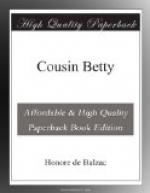And yet they are all of equal merit. Nay, more. The Stanze, the Transfiguration, the panels, and the three easel pictures in the Vatican are in the highest degree perfect and sublime. But they demand a stress of attention, even from the most accomplished beholder, and serious study, to be fully understood; while the Violin-player, the Marriage of the Virgin, and the Vision of Ezekiel go straight to the heart through the portal of sight, and make their home there. It is a pleasure to receive them thus without an effort; if it is not the highest phase of art, it is the happiest. This fact proves that, in the begetting of works of art, there is as much chance in the character of the offspring as there is in a family of children; that some will be happily graced, born beautiful, and costing their mothers little suffering, creatures on whom everything smiles, and with whom everything succeeds; in short, genius, like love, has its fairer blossoms.
This brio, an Italian word which the French have begun to use, is characteristic of youthful work. It is the fruit of an impetus and fire of early talent—an impetus which is met with again later in some happy hours; but this particular brio no longer comes from the artist’s heart; instead of his flinging it into his work as a volcano flings up its fires, it comes to him from outside, inspired by circumstances, by love, or rivalry, often by hatred, and more often still by the imperious need of glory to be lived up to.
This group by Wenceslas was to his later works what the Marriage of the Virgin is to the great mass of Raphael’s, the first step of a gifted artist taken with the inimitable grace, the eagerness, and delightful overflowingness of a child, whose strength is concealed under the pink-and-white flesh full of dimples which seem to echo to a mother’s laughter. Prince Eugene is said to have paid four hundred thousand francs for this picture, which would be worth a million to any nation that owned no picture by Raphael, but no one would give that sum for the finest of the frescoes, though their value is far greater as works of art.
Hortense restrained her admiration, for she reflected on the amount of her girlish savings; she assumed an air of indifference, and said to the dealer:
“What is the price of that?”
“Fifteen hundred francs,” replied the man, sending a glance of intelligence to a young man seated on a stool in the corner.
The young man himself gazed in a stupefaction at Monsieur Hulot’s living masterpiece. Hortense, forewarned, at once identified him as the artist, from the color that flushed a face pale with endurance; she saw the spark lighted up in his gray eyes by her question; she looked on the thin, drawn features, like those of a monk consumed by asceticism; she loved the red, well-formed mouth, the delicate chin, and the Pole’s silky chestnut hair.




